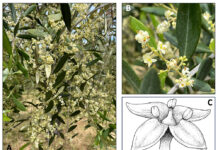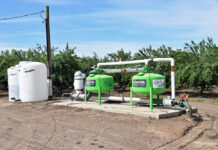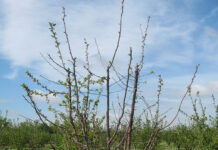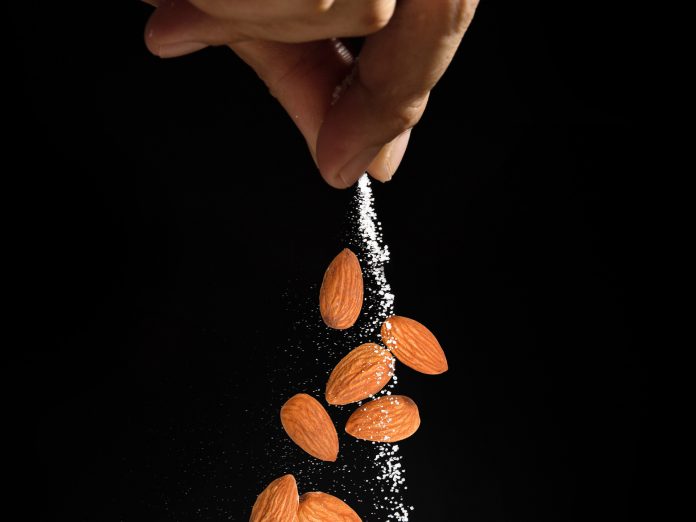Good quality water is extremely important for agriculture throughout the world. However, due to reduced availability of water and increasing food demands, future use of degraded waters is evident. One of the major concerns of utilizing degraded waters for irrigation is their high salt concentration.
Salinity is one of the main abiotic stresses faced by the agriculture industry. Modest increase of soil salinity level impacts both plant growth and yield by causing several physiological and biochemical changes. Based on salt tolerance level plants are classified broadly in two groups: halophytes and glycophytes. The halophytes have special mechanisms to tolerate high concentrations of salts and therefore can grow in saline environments. The majority of plants (including almonds) are glycophytes and cannot tolerate high salt concentrations and so grow in soil containing low salts. However, among glycophytes, salt tolerance level varies tremendously not only at the species level but also at the variety level within a species. This variation is directly dependent on the functional status of various molecular components that play critical roles to protect plant during salt stress.
In the initial stages of salinity exposure, a plant faces osmotic stress, resulting in ion imbalance in cells, membrane disintegration and reduced photosynthesis. In addition, osmotic stress in the root sends a signal throughout the plant causing reprograming of physiological and molecular activities to initiate defense response against salinity stress. Slowly ionic stress develops, leading to accumulation of Na+ (sodium ions) and Cl- (chloride ions) in plant tissues. High ion concentrations are not only toxic but also interfere with absorption of essential nutrients by a plant. High Na+ and Cl- levels interfere in many molecular, biochemical, metabolic and physiological processes which could also lead to unnatural senescence and cell death. For plant species that are moderately tolerant to salinity, osmotic stress may play an important role. However, for species sensitive to salinity such as almonds, low salt concentration is able to impose ionic stress that may reach to an intolerable level, whereas it may not generate osmotic stress critical for plant growth. Hence, when studying salinity stress in almonds, it is important to focus on responses related to ionic stress and the exposure to salinity should be gradual to avoid any osmotic shock. This also mimics field conditions in an almond orchard, as during spring salt moves to subsurface layers due to the rain and slowly moves to upper layers during summer, which leads to gradual increase in root zone salinity.
Due to a continuous increase in cultivated area under almonds, farmers are forced to utilize marginal lands with low quality saline water for irrigation. In almonds, rootstock plays an important role in regulating plant growth in salinity stressed environment. Hence, the development of new almond rootstocks tolerant to salinity is highly desirable. In last two decades, several studies focusing on screening almond rootstocks for salinity tolerance have been conducted and some tolerant rootstocks have been identified. However, a comprehensive approach to screen and develop new rootstocks with enhanced salinity is missing in almonds.
Impact of Salinity on Water Relations and Photosynthesis
Water uptake by a plant is drastically affected under salinity, which leads to reduced water potential, relative water content, stomatal conductance and transpiration. As plants take nutrients with water, reduced water uptake also decreases tissue concentration of essential nutrients affecting plant growth. In addition, high salt concentrations also affect homeostasis, osmoregulation and net photosynthesis. Photosynthesis is the most critical metabolic process for almonds. In response to salinity, osmotic stress-mediated stomatal closure prevents water loss through transpiration in plants that also restricts the amount of CO2 taken in for photosynthesis. Consequently, stomatal conductance, net photosynthetic rate and amount of chlorophyll are used as physiological parameters to study salinity tolerance in different almond varieties. In a recent study where we compared several rootstocks for salinity tolerance, photosynthetic rate was found to be the most reliable parameter to assess salinity tolerance.
Tissue Ion Composition and Salinity Tolerance
Tissue Na concentration is commonly used as a guide for the salinity tolerance of a variety. However, for some plant species, tissue Na concentration is not a true indicator of salt tolerance of a variety. Never-the-less, for almonds the negative correlation between tissue Na concentration and salt tolerance holds well. Similar to Na accumulation, salt tolerant genotypes stored least amount of Cl in leaf tissue.
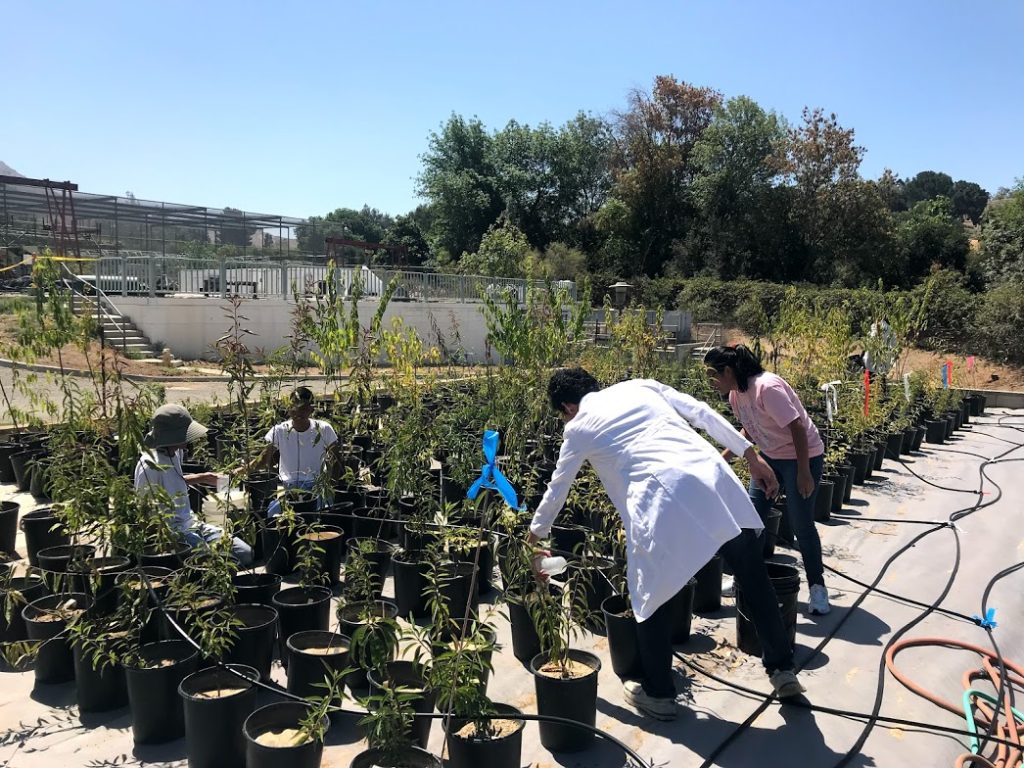
Genetic Control of Salinity Tolerance
In model plants, hundreds of genes have been discovered that play critical roles in salinity tolerance. Salt-stress induced signaling pathways have also been well-dissected. Molecular mechanisms of salt tolerance or salt sensitivity is largely unknown in almonds. Expression analysis of genes involved in ion transport in almond tissue showed induction of multiple genes involved in Na+ and Cl– transport under salinity treatment, suggesting importance of both Na and Cl during salinity stress. The genes involved in Na+ transport were differentially expressed during salinity stress, compared to the control. For instance, NHX1 (a vacuolar sodium/proton antiporter) and SOS3 (SALT OVERLY SENSITIVE 3 that encodes a calcium sensor) were upregulated in leaves and on the other hand HKT1 (encodes a Na transporter) was induced in roots under salinity treatment. SOS3 is involved in Na+ exclusion from roots, NHX1 plays role in sequestering Na+ in vacuole and HKT1 is critical for retrieving Na+ from xylem back into root to protect leaves from salt toxicity. Additionally, CLC-C (chloride channel C) and SLAH3 (encodes a slow-type anion channel) that are important for Cl– transport, were highly upregulated in salinity treatments in almond roots. These observations confirmed the role of multiple component traits in salt tolerance mechanism in almonds. As seen in other plants, multiple signaling pathways and various genes are expected to be involved in establishing ionic homeostasis during salt stress. Nevertheless, there are not many studies focusing on understanding the roles of organic solutes and enzymatic or non-enzymatic antioxidants in mitigating effects of salinity in almonds. Although some genes involved in ion exclusion, and ion sequestration in vacuoles have been identified in almonds, future studies are warranted to identify additional genes. In addition, different scions should also be compared for the genetic variation involved in ion homeostasis and scavenging reactive oxygen species (ROS) produced during salinity stress, which may provide some insights into sensitivity of almonds to salinity.
Contrary to studying the importance of a few genes in salinity stress at a time, an RNA-seq based approach compares global changes in gene expression between the control and the salinity treatments. In addition to targeting genes already characterized in model plants this strategy can link different pathways involved in salinity tolerance and identify specific almond genes contributing toward salt tolerance.
Can Alternate Approaches Mitigate Harmful Effects of Salinity?
Many additional strategies have been reported in plants that have been implicated to improve salt tolerance level in response to salt stress. For instance, application of certain microbes could improve salt tolerance level of plants. Arbuscular mycorrhizal fungi (AMF) are known to form symbiotic associations with many land plants that considered to be valuable to plant growth. AMF helps host plants not only by providing essential minerals but also by impeding the translocation of toxic ions like sodium. The use of AMF in multiple plant species has shown enhanced growth, development and productivity under salt stress. Although, different Prunus rootstocks have been screened for mycorrhizal colonization, direct effect of AMF in mitigating salinity still need to be established.
Application of plant growth promoting rhizobacteria (PGPR) is also known to improve salt tolerance in different plant species. However, there are no published reports describing effect of PGPR in improve salt tolerance in almonds.
Although, AMF and PGRP show a lot of promise, the potential of their application on almond rootstocks to mitigate salinity stress needs to be explored further, along with the economic feasibility of these approaches at the commercial level.
Future Perspectives
One of the main consequences of the climate change is the length and frequency of drought periods experienced in certain part of the world. California, the main almond producing region of the world, experienced a long drought period in the recent past. Drought leads to excessive groundwater pumping and use of alternative water resources with high salinity for irrigation. Based on the current trends, salinity problem is expected to intensify in next couple of decades. Currently, salinity screening is taking a backseat in almond rootstock breeding, which is expected to change in the near future. One of the approaches for the future almond breeding programs will require screening of wild genetic material for salinity tolerance. In addition to the other important rootstock traits such as high vigor, nematode resistance, disease resistance, insect resistance, drought tolerance, salinity tolerance should also take central stage during rootstock breeding.
Identification and isolation of the key almond genes involved in salinity tolerance will be critical. Functional validation of selected almond genes by complementation assay in a model plant like Arabidopsis may provide an initial proof of functional conservation of genes between these species. Characterization of genes will facilitate identification of specific mutations that are critical for salinity tolerance. The CRISPR/Cas9 system has a great potential in fixing the both type of genes that play positive or negative roles in salt tolerance in almonds. The CRISPR/Cas9 is a precise, suitable, and efficient technology that has been used for genome editing in various crops such as rice, wheat, maize and sorghum. It is important to note that CRISPR/Cas9 modified crops are not considered as genetically modified organisms (GMO).
Identification and characterization of genes regulating ion uptake, effective compartmentalization, and tissue tolerance may provide new means to develop almond varieties with enhanced salinity tolerance.


